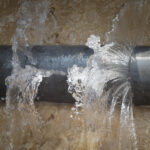In parts one and two of this multi-part blog series, we’ve gone over some of the basic methods for homeowners to take – often with the assistance of our plumbers – to prevent significant flooding risks. Both in plumbing-specific areas and many others to do with your property, including issues like sloping, flood zones and related concerns, preventing flood risks is important not only for basic occupant safety, but also for home value.
At Action Plumbing, Heating, Air & Electric, we’re happy to provide immediate response services to any plumbing emergency, including those featuring flooding risks or related themes. Today’s part three of our series will focus on some final areas you and our plumbers may choose to focus on when it comes to limiting these risks, then part four will finish up by digging into how you should respond in a situation where a flood has already begun taking place in your home.
Perforated Drain Pipes
One addition to some homes that have had flooding issues in the past are known as perforated drain pipes, also called weeping tiles in some circles. These are perforated drainage solutions that collect water and then redirect it out to a suitable location away from the property.
Now, perforated drain pipes are not an inexpensive addition to the home. But when compared with the cost of water damage due to flooding, the cost is actually really low. This is mostly an installation we won’t recommend unless the property has had previous flooding issues in the past or shows major such concerns currently – but if so, it’s a great method for reducing water buildup in any area.
Storm Windows
For areas that experience major storms, from snow buildup to other related concerns, one item you might consider installing is the storm window on all your basement window openings. The storm window has a drainage layer that can extend all the way to perforated drain pipes, if you’ve also installed these – between the two, the chances of significant water buildup from any source taking place in your basement will be very low.
Reverse-Slope Driveways
Finally, for homes with reverse-slope driveways, flooding can be a larger concern since water flows toward your home instead of away from it. Some capable homeowners combat this by choosing to build or small a rise that will raise the slope so it goes the other way; there are other construction alternatives here with local contractors that our team will be happy to inform you of. And if you’re looking at new homes and don’t want to deal with flooding risks, we strongly recommend avoiding any properties with reverse-slope driveways.
For more on how to prevent plumbing-related and other flood risks from impacting your property, or to learn about any of our plumbing or HVAC services, speak to the staff at Action Plumbing, Heating, Air & Electric today.


